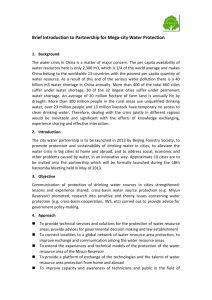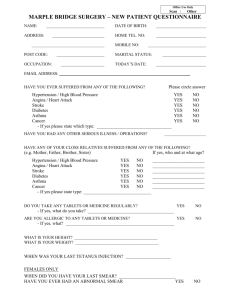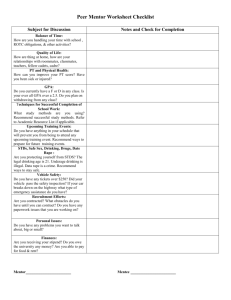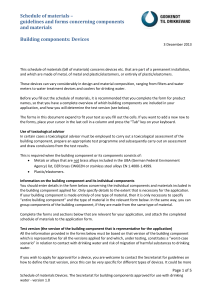Devices - Godkendt til drikkevand
advertisement
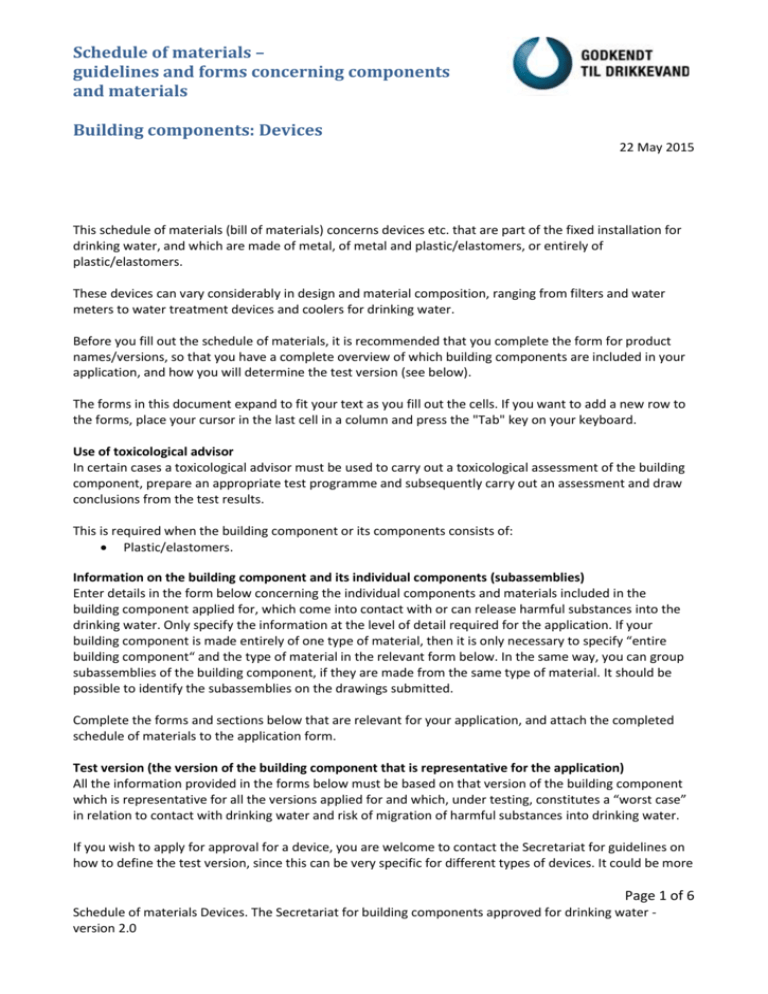
Schedule of materials – guidelines and forms concerning components and materials Building components: Devices 22 May 2015 This schedule of materials (bill of materials) concerns devices etc. that are part of the fixed installation for drinking water, and which are made of metal, of metal and plastic/elastomers, or entirely of plastic/elastomers. These devices can vary considerably in design and material composition, ranging from filters and water meters to water treatment devices and coolers for drinking water. Before you fill out the schedule of materials, it is recommended that you complete the form for product names/versions, so that you have a complete overview of which building components are included in your application, and how you will determine the test version (see below). The forms in this document expand to fit your text as you fill out the cells. If you want to add a new row to the forms, place your cursor in the last cell in a column and press the "Tab" key on your keyboard. Use of toxicological advisor In certain cases a toxicological advisor must be used to carry out a toxicological assessment of the building component, prepare an appropriate test programme and subsequently carry out an assessment and draw conclusions from the test results. This is required when the building component or its components consists of: Plastic/elastomers. Information on the building component and its individual components (subassemblies) Enter details in the form below concerning the individual components and materials included in the building component applied for, which come into contact with or can release harmful substances into the drinking water. Only specify the information at the level of detail required for the application. If your building component is made entirely of one type of material, then it is only necessary to specify “entire building component“ and the type of material in the relevant form below. In the same way, you can group subassemblies of the building component, if they are made from the same type of material. It should be possible to identify the subassemblies on the drawings submitted. Complete the forms and sections below that are relevant for your application, and attach the completed schedule of materials to the application form. Test version (the version of the building component that is representative for the application) All the information provided in the forms below must be based on that version of the building component which is representative for all the versions applied for and which, under testing, constitutes a “worst case” in relation to contact with drinking water and risk of migration of harmful substances into drinking water. If you wish to apply for approval for a device, you are welcome to contact the Secretariat for guidelines on how to define the test version, since this can be very specific for different types of devices. It could be more Page 1 of 6 Schedule of materials Devices. The Secretariat for building components approved for drinking water version 2.0 Schedule of materials – guidelines and forms concerning components and materials Building components: Devices 22 May 2015 appropriate to apply for approval of certain devices using another schedule of materials e.g. pipes and hoses or fittings, manifolds, valves etc. The Secretariat can guide you on this. You can also contact a toxicological advisor and define the test version together with the toxicological advisor. Under all circumstances, you should have a toxicological advisor employed to carry out a toxicological assessment and prepare a test programme in the above cases. The test programme defines and substantiates which version should be tested. If possible, the building component or components of plastic/elastomers should be tested with a surface area-to-volume ratio of 1, i.e. an area of 1 cm2 corresponds to 1 ml water. Specification of the test version In this form, specify the test version of the device for which you are completing the forms below. Brand name Product name Item / serial number Dimension: DN, volume or other relevant dimensions (Optional) Note: There is no requirement to test devices made entirely of stainless steel alloys EN 1.4000-1.4999, and it is therefore not necessary to specify a test version. If more test versions are used, they must all be specified. Test versions that are not covered by the application cannot be listed. Exemptions of components in marginal contact with drinking water Should you wish to exempt individual components in the building component from testing, then follow these guidelines: Some types of individual component are only in marginal contact with drinking water, either in terms of area or time, and as they are not in significant contact with drinking water, they are therefore exempted from assessment and testing. The area exemption is relevant for small individual components, which as a rule have a surface area in contact with drinking water of less than 4 cm2 when the building component is in use, such as O-rings, small gaskets and other small individual components. The time exemption is relevant for individual components which are in contact with drinking water for less than 30 minutes at a time, e.g. if the contact with drinking water is limited to contact while draining the water. You can see a list of examples of exemptions on the website for the scheme. The Secretariat does not need information on such individual components that are exempted, but they must be included and shown in drawings or other material in the application. If you believe that there are other individual components in the building component that have only marginal contact with drinking water, either in terms of area or time, then enter them in this form and explain more detailed why they should be exempted from assessment and testing. If the explanation Page 2 of 6 Schedule of materials Devices. The Secretariat for building components approved for drinking water version 2.0 Schedule of materials – guidelines and forms concerning components and materials Building components: Devices 22 May 2015 relates to marginal contact in terms of area, then the surface area in contact with drinking water of the individual component must always be specified. Components in marginal contact with drinking water Arearelated Timerelated (Tick here) (Tick here) Reason Components and materials in contact with drinking water, that can carry a risk of migration of harmful substances into drinking water In the form below, specify under points A and B all the individual components that are in contact with drinking water, or could otherwise cause migration of harmful substances into drinking water, and which, in scope (area) and degree of contact (time), have significant contact with the drinking water (i.e. are not exempted because of marginal contact with drinking water). If the building component is manufactured and placed on the market with combinations of different subassemblies, all of these subassemblies should be entered on the form below. If an individual component has a separate, valid “Approved for use with drinking water” approval (GDV approval) or a VA approval (health-related properties), which you would like to use as a basis for the application instead of testing the component, then the relevant approval number for the component should be specified. For VA approvals, only approvals of components that have been VA-approved with regard to health-related properties before 1 April 2013 and that are still valid, can be used as a basis for approval. It is also necessary to attach the actual VA approval to the application. Foreign approvals should generally not be referred to or attached, but there may be a basis or background documentation for foreign approvals that might be used as documentation. It may for example be specific foreign toxicological evaluations, test programs and test results, provided that they are in accordance with the requirements of the Approval Executive Order and therefore may be included as documentation for the building component under application. If you plan to base your application for approval of a building component on a component that is in the process of being “Approved for use with drinking water”, then the case number for the application for approval of the component as an independent building component should be specified instead. In such a case, the processing of your application will have to await the issue of an approval for the individual component as an independent building component. A. Metal components Specify below the types of alloy for the metal components contained in the building component by completing forms 1 and 2 to the extent that is relevant for your building component. Proceed directly to the next section if your building component does not contain metal. Page 3 of 6 Schedule of materials Devices. The Secretariat for building components approved for drinking water version 2.0 Schedule of materials – guidelines and forms concerning components and materials Building components: Devices 22 May 2015 Specify either the alloy number or the formula/composition. Other documentation for the alloy type is not required. You must also specify if there are special coatings on the component or substances from the manufacturing processes, which can migrate into drinking water. 1. Stainless steel alloys EN 1.4000-1.4999 It is no required to test stainless steel alloys of type EN 1.4000-1.4999. Specify the alloy type below. However, if the component is chrome-plated or nickel-plated then it must be tested for nickel in accordance with table 2 in Annex 1 of the Approval Executive Order. It is therefore necessary in these cases to attach test documentation for nickel carried out as accredited testing on three trial samples in accordance with table 2 in Annex 1. Component Alloy (Specify alloy type) Chrome plating/ Nickel plating (Tick here) Coating/ substances from manufacturing processes, if relevant GDV approval (“Approved for use with drinking water”) / VA approval (Specify) (Specify approval number) 2. Other metal alloys All other metal alloys must be tested for lead and cadmium according to table 2 in Annex 1 of the Approval Executive Order. Specify the alloy type below. If the component is chrome plated-or nickel-plated, then the component must also be tested for nickel according to table 2 in Annex 1. It is therefore necessary to attach test documentation for nickel carried out as an accredited test on three trial samples in accordance with table 2 in Annex 1. You must also specify if there are special coatings on the component or substances from manufacturing processes that might migrate into drinking water. Control of the traceability between the alloy type and material documentation is included in the annual inspection. Component Alloy (Specify alloy type) Chrome plating/ Nickel plating (Tick here) Coating/ substances from manufacturing processes, if relevant (Specify) GDV approval (“Approved for use with drinking water”) / VA approval (Specify approval number) Page 4 of 6 Schedule of materials Devices. The Secretariat for building components approved for drinking water version 2.0 Schedule of materials – guidelines and forms concerning components and materials Building components: Devices 22 May 2015 B. Components of plastic/elastomers or other types of material. Specify below the types of plastic/elastomers or other types of material that the building component contains by completing the form to the extent relevant for your building component. Proceed directly to the next section if your building component does not contain plastic/elastomers or other types of material than metal. For all plastic or elastomer components or other types of material (except those that are exempt, either generally or specifically, as mentioned above) a test programme based on a toxicological assessment must be drawn up and tests undertaken according to table 1 in Annex 1 of the Approval Executive Order for relevant substances that can influence drinking water. You should attach the toxicological advisor's assessment and test programme, the relevant test documentation and the toxicological advisor's assessment of the test result. Component Material type GDV approval (“Approved for use with drinking water”) / VA approval (Specify approval number) Declaration on "on-demand" production If the building component application should also include “on-demand” products, then the product range to be covered by the approval should be specified in the form below. “On-demand” products means that you would like to manufacture your building component in variants that currently do not exist, for example based on customer requests, within a given product range. In "ondemand" production, the building component can be delivered upon special request from a specific customer ordering the same version of the building component in terms of design, manufacturing process and materials, but in a variant with special dimensions that do not match any of the versions in the version list. You should only choose on-demand production if you are already using such production or if you have concrete plans to use it. If you only want to market and produce the variants you have specified in your list of product names/versions, you should not complete the form below. The product range for on-demand products should comply with the test version of the building component, which forms the basis of the application. The applicant must solemnly declare that the “on-demand” products that the company will manufacture with reference to the approval of the building component under application, will be within the specified product range. Brand name Product name Overall item number /serial number /type /model Page 5 of 6 Schedule of materials Devices. The Secretariat for building components approved for drinking water version 2.0 Schedule of materials – guidelines and forms concerning components and materials Building components: Devices 22 May 2015 (Optional) Product range for “on-demand” products included DN Smallest Largest Length Smallest Largest Other Other Page 6 of 6 Schedule of materials Devices. The Secretariat for building components approved for drinking water version 2.0



